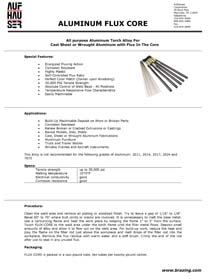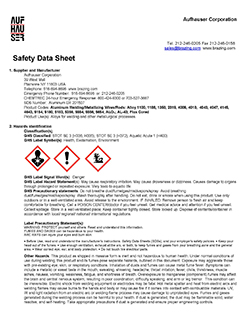Aluminum Flux Core
INTRODUCTION
All purpose Aluminum Torch Alloy for cast sheet or wrought aluminum with flux in the core.
MAJOR ADVANTAGES
- Energized Fluxing Action
- Corrosion Resistant
- Highly Plastic
- Self-Controlled Flux Ratio
- Perfect Color Match (darker upon anodizing)
- 30,000 PSI Tensile Strength
- Absolute Control of Weld Bead - all positions
- Temperature Responsive Flow Characteristics
- Easily Machinable
APPLICATIONS
- Build-Up Machinable Deposit on Worn or Broken Parts
- Corrosion Resistant
- Renew Broken or Cracked Extrusions or Castings
- Revise Models, Dies, Molds
- Cast, Sheet or Wrought Aluminum Fabrications
- Aluminum Furniture
- Truck and Trailer Bodies
- Window Frames and Aircraft Instruments
- This Alloy is not recommended for the following grades of aluminum: 2011, 2014, 2017, 2024 and 7075
GENERAL INFORMATION
PHYSICAL and MECHANICAL PROPERTIES
| Melting Temperature | 1075°F (579°C) |
| Tensile Strength | up to 30,000 psi |
| Electrical Conductivity | good |
| Corrosion resistance | good |
STANDARD SIZING
| Package: 2 lbs tube, 10 tubes per 20-lbs carton |
PROCEDURE
Clean the weld area and remove all plating or anodized finish. Try to leave a gap of 1/16" to 1/8". Bevel 60° to 70° where butt joints or cracks are involved. It is unnecessary to melt the base metal. Use a carburizing flame and heat the work piece by keeping the flame 1" to 3" from the surface. Touch FLUX-CORE to the weld area under the torch flame until the filler metal flows. Deposit small amounts of alloy and allow it to flow out on the weld area. For build-up work, reduce the heat and play the flame on the filler rod just above the workpiece and melt drops of the filler rod into the workpiece. Remove the flux residue with warm water and a stiff brush. Crimp the end of the rod after use to seal in any unused flux.
Also available: Stainless Steel Flux Cored



